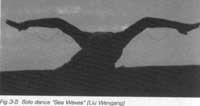EXCEPTS FROM CHINESE DANCE
by Sun Jingchen, Luo Xiongyan, Zi Huayun
Jia Zuoguang
Son of the Pastureland
Dance works of jia Zuoguang remind people of galloping horses and soaring swans. This is not only because he created "Herding Horses" and "Swan Goose", but also because of his character.
Jia was a Manchurian, but he spent most of his life on the pastureland of the lnner Mongolia Autonomous Region. He called himself "Hudeqinfu" (son of the pastureland in Mongolian language), while the herdsmen called him "Manai" (ours). He was regarded as the founder of Mongolian dance.
Jia Zuoguang was born into a peasant family in the Suburbs of Shenyang, Liaoning Province, in 1923. At the age of 15, he passed the examination and entered the children's dance class under the "Manchuria Film Association" (predecessor of Changchun Film Studio). From the Japanese modern dance master Baku Ishii, he learned ballet and modern dance as well as classical music, drawing and literature. His natural gifts and exceptional diligence immediately brought out his talent.
To avoid the Japanese army, he escaped to Peking (now Beijing). In 1942, he held a solo dance performance, at which he performed the programs full of just and national feelings such as "Hometown", "Soul of the State", "Child Standard-Bearer" and "Devil". These aroused a feeling of patriotism among the common people who did not want to be enslaved.
 In the late 1940s, jia Zuoguang led his people to newly Iiberated areas in the Inner Mongolia Autonomous Region. The boundless prairie kindled the youths' enthusiasm. They put on a Mongolian long gown and galloped on the vast pastureland. jia engaged in small talks with Mongolian grannies and trained horses, milked and cut grass with young people. During festivals, he attended horsemanship and marksmanship and wrestling competitions. At the local banquets, he drank and sang with the local people. When he talked about the dances of herdsman, he said, "How magnificent! How plentiful! I was shocked. I wanted to communicate with them through dance." Consequently, he began collecting the folk dances of the pastureland like a gold-washer All the works he produced have a strong sense of life, various folk colors and exquisite dance skills.
In the late 1940s, jia Zuoguang led his people to newly Iiberated areas in the Inner Mongolia Autonomous Region. The boundless prairie kindled the youths' enthusiasm. They put on a Mongolian long gown and galloped on the vast pastureland. jia engaged in small talks with Mongolian grannies and trained horses, milked and cut grass with young people. During festivals, he attended horsemanship and marksmanship and wrestling competitions. At the local banquets, he drank and sang with the local people. When he talked about the dances of herdsman, he said, "How magnificent! How plentiful! I was shocked. I wanted to communicate with them through dance." Consequently, he began collecting the folk dances of the pastureland like a gold-washer All the works he produced have a strong sense of life, various folk colors and exquisite dance skills.
From the 1940s to 1980s, jia Zuoguang created a large number of excellent works.
The solo dance "Herding Horses" choreographed and performed by Jia himself in the 1940s successfully presented to us a broad-minded herdsman good at riding. (Fig.3-4)
 His "Erdos Dance" finished in the 1950s (a group dance composed by Ming Tai and premiered by Siqin Tariha and Liang Huimin) for the first time made the plateau tribe known to the world. It won the golden award in the Fifth World Youth Festival.
His "Erdos Dance" finished in the 1950s (a group dance composed by Ming Tai and premiered by Siqin Tariha and Liang Huimin) for the first time made the plateau tribe known to the world. It won the golden award in the Fifth World Youth Festival.
The "Sea Waves" in the 1980s (a male solo dance composed by Yang Zhihua and premiered by Liu Wengang) combined perfectly the images of seagulls and sea waves by concise and distinct dance steps and superb skills, showing the dauntless spirit that fights against storms.(Fig.3-5)
The three works mentioned above are included in the Dance Classics of the Chinese Nation in the 20th Century.
Though jia Zuoguang came after Wu Xiaobang and Dai Ailian, his creative contributions rank him among the pioneers of new Chinese dance. His works about Mongolia are of great significance to the development of the dances of other ethnic groups.
Wu Xiaobang, Dai Ailian and Jia Zuoguang, though totally different in terms of life experience and style, share some common features in developing the modern Chinese dances. They are all progressive representatives and leaders of Chinese dance in the 20th century, especially after the foundation of the People's Republic of China.
